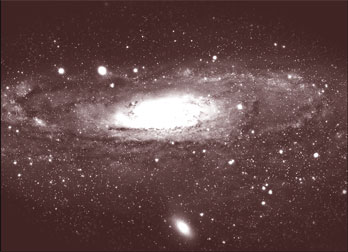A tantalising prospect
 Do you like to look at the sky at night and wonder how far all those
twinkling little stars are? They are indeed hundreds of light years
away, although a few are ‘just’ four or five light years away. A light
year being the distance that light travels in a year at 300,000 Km per
second, even Alpha Centauri, the nearest star, lies at a distance we
cannot comprehend. And chances are that when we look at the night sky,
we are looking at our own galaxy, the sweetly named Milky Way. Do you like to look at the sky at night and wonder how far all those
twinkling little stars are? They are indeed hundreds of light years
away, although a few are ‘just’ four or five light years away. A light
year being the distance that light travels in a year at 300,000 Km per
second, even Alpha Centauri, the nearest star, lies at a distance we
cannot comprehend. And chances are that when we look at the night sky,
we are looking at our own galaxy, the sweetly named Milky Way.
The Milky Way is a spiral galaxy, one of the billions of galaxies in
the universe. Our galaxy is about 100,000 light-years wide. We’re about
25,000 light-years from the centre of the galaxy. Our local Orion Arm of
the Milky Way is some 3,500 light years across. It’s approximately
10,000 light years in length. This gives us an idea of how big our own
Milky Way is, leave alone the other galaxies.
Scientists are getting a clearer idea of how many stars are out there
in our little corner of the universe. Even more importantly, they now
have a clearer picture of how many planets are circling those suns. This
is a far cry from the days when our telescopes could not even detect one
exoplanet, as planets outside our solar system are known.
|

The Milky Way |
In the latest findings published in scientific journals, scientists
estimate that the Milky Way alone has around 100 billion stars, with
nearly all of them having planets. (There are two-star “Tatooine”
planetary systems as well).
That translates into 100 billion planets. But how many of them are
similar to Earth, at least in size? The figure is around 17 billion.
Yes, there could be as many as 17 billion Earth-like planets in our
galaxy alone. That's more than two Earth-size planets for every person
on the globe. Carl Sagan said as much all those years ago.
Milky Way
If the Milky Way alone has 100 billion planets, just think of the
number of stars and planets in the entire universe. According to
conservative estimates, there could be more than 175 billion galaxies
(not individual stars) in the whole universe based on what can be seen
with our space telescopes.
There could be many more. The number of planets in the entire
universe is thus beyond our imagination.
The next big question is, how many of them would be actually like the
Earth apart from the size factor. How many of these planets could be
having water and other essential ingredients for life, if not life
itself? The answer is that we do not know – yet. Just how many are
located in the sweet spot where water could exist (the so-called
Goldilocks zone where it's not too hot or too cold for water to be in
liquid form on the surface) is “simply too early to call,” says Francois
Fressin of the Harvard-Smithsonian Center for Astrophysics, one of the
researchers who announced the discovery.
Despite this discovery, we have still not found Earth 2.0. That will
take some more time - several decades at least. Perhaps one of our
robotic probes will find a second Earth or an alien civilisation might
choose to contact us and tell us where they live.
Indeed, this celestial discovery poses a tantalising question which
this column has raised again and again.
Does life exist outside Earth? With 17 billion planets to choose
from, one is inclined to believe that at least a few million of these
planets could be harbouring some of life - intelligent or otherwise.
And we have not even mentioned the moons that could be orbiting these
planets and some of them could be candidates for life, just as there are
suspicions that some moons in our own Solar System could be hosting at
least rudimentary forms of life.
Nevertheless, this figure of 17 billion planets for the Milky Way
remains an estimate, a good guess. Scientists have actually spotted only
around 3,000 exoplanets. The Kepler space telescope continues to spot
planets as they pass between Earth and the star they orbit. The Kepler
telescope locates planets by monitoring a patch of the sky 115 square
degrees in extent. (For comparison, the full Moon is about 0.2 square
degrees.) The telescope watches for slight variations in the light of
stars that could indicate a transit: the small eclipse created when a
planet passes in front of the star. The duration and depth (how much
light is blocked) of the transit reveals information about the size of
the planet and its orbit.
Goldilocks zone
Kepler found 461 new candidate planets recently. Most of the new
Kepler finds were driven by discoveries of Earth-size planets and
super-Earths. Four of those are thought to reside in the life-giving
Goldilocks zone, but more observations are needed before coming to a
firm conclusion.
But as astronomers point out, habitability is a function both of
location and of history. Two classic examples are Venus and Mars in our
solar system. Venus lies within the solar system's habitable zone, but
has no liquid surface water and Mars, outside the habitable zone, has
evidence of past surface water. Either way, there is a possibility of
life - past or present - on these planets.
There is a school of thought that the funds wasted on exploring and
hunting for other planets and indeed, other life forms, could be used to
solve the problems affecting the seven billion people on Earth such as
hunger and poverty. This argument has some validity in the short term,
but we are explorers by nature. We are inquisitive about our world - and
other worlds.
The more we learn about other worlds, the more we understand about
our own. We yearn to break free from the eyepiece of the telescope and
actually set foot on these exotic, mysterious worlds.
We seek progress, knowing very well that we may have to leave the
Earth one day in the far future for distant worlds.
By that time, we will have a very clear idea of how many Earth-like
worlds are out there in the deep corners of space. Furthermore, any
confirmation that we are not alone in the Universe will fundamentally
alter the way we look at ourselves and life itself.
|



